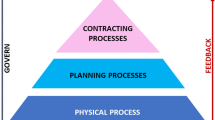Abstract
Many different private companies – shipping lines, terminal operating companies, forwarders, hinterland transport providers, and inland terminal operators – are involved in hinterland transport. In addition, different public actors such as the port authority, customs, and infrastructure managers are involved. Creating effective hinterland transport chains requires the coordination between all these actors; coordination does not come about spontaneously. Its development may be hindered by free-riding problems, a lack of contractual relationships, information asymmetry, and a lack of incentives for cooperation. This paper presents analyses of the coordination problems in hinterland chains of seaports and arrangements to resolve these problems. The most relevant coordination problems in hinterland chains are discussed. Based on insights from institutional economics, four main categories of arrangements to improve coordination are identified: the introduction of incentives, the creation of an interfirm alliance, changing the scope of the organisation, and collective action. An analysis is presented of a substantial number of coordination arrangements in hinterland transport to and from the port of Rotterdam, thereby indicating how coordination could be improved.



Similar content being viewed by others
Notes
Only a few container truck companies have a truck fleet of more than 50 units. The average truck fleet is 5–7 TEU, which is very small in comparison with other transport companies in the hinterland chain.
The mechanism is related to the concept of property rights. A primary function of property rights is that of guiding incentives to achieve a greater internalisation of externalities (Demsetz, 1967).
References
Ballou, RH . 2004: Business logistics: Planning, organizing and controlling the supply chain. 5th edition. Pearson Education: Upper Saddle River.
Bundesamt für Güterverkehr. 2005: Marktbeobachtung Güterverkehr, Sonderbericht zum Seehafen-Hinterlandverkehr. Bundesamt für Güterverkehr: Köln.
Coase, RH . 1937: The nature of the firm. Economica 4: 386–405.
Coase, RH . 1960: The problem of social cost. Journal of Law and Economics 3: 1–44.
De Langen, PW . 2004: The performance of seaport clusters, a framework to analyze cluster performance and an application to the seaport clusters of Durban, Rotterdam, and the Lower Mississippi, Rotterdam. Erasmus Research Institute of Management Ph.D. series, Rotterdam.
De Langen, PW and Chouly, A . 2004: Hinterland access regimes in seaports. European Journal of Transport and Infrastructure Research 4: 361–380.
Demsetz . 1967: Towards a theory of property rights. American Economic Review 57: 347.
Groothedde, B . 2005: Collaborative logistics and transportation networks: A modeling approach to hub network design. Trail-Thesis Series T2005/15, Trail, Delft.
Halldorsson, A, Kotzab, H, Mikkola, JH and Skjott-Larsen, T . 2005: How inter-organisational theories contribute to supply chain management, theoretical foundation and application. In: De Koster, R ànd Delfmann, W (eds) Supply Chain Management in European Perspective. Copenhagen Business School: Copenhagen.
Heaver, T, Meersman, H, Moglia, F and Voorde, E van de . 2000: Do mergers and alliances influence European shipping and port competition? Maritime Policy & management 27: 363–374.
Konings, JW . 1996: Integrated centers for the transshipment, storage, collection and distribution of goods: A survey of the possibilities of a high quality intermodal transport concept. Transport Policy 3: 3–11.
Konings, JW . 2005: Foldable containers to reduce the costs of empty transport? A cost-benefit analysis from a Chain and multi-actor perspective. Maritime Economics and Logistics 7: 223.
Midoro, R, Musso, E and Parola, F . 2005: Maritime liner shipping and the stevedoring industry: Market structure and competition strategies. Maritime Policy and Management 32: 89–106.
Moonen, H, Van der Rakt, Miller, I, Van Nunen, J and Van Hillegersberg, J . 2005: Agent technology supports inter-organizational planning in the port. Erasmus Research Institute of Management: Rotterdam.
Nieuwsblad Transport. 2007: Maersk stapt in inland terminals. Nieuwblad Transport, 24 January 2007.
Nooteboom, B . 1992: Towards a dynamic theory of transactions. Journal of Evolutionary Economics 2: 281–299.
Nooteboom, B . 2004: Inter-firm collaboration, learning and networks: An integrated approach. Routledge: London.
Notteboom, T and Konings, R . 2003: Organisational changes in the European barging industry and its impact on the barging network. Paper presented at Research Seminar Maritime Transport, Globalisation, Regional Integration and Territorial Development, Le Havre, June 2003.
Notteboom, T and Winkelmans, W . 2004: Factual report on the European port sector: FR-WP1: Overall market dynamics and their influence on the port sector. European Sea Ports Organisation (ESPO): Brussels.
Notteboom, TE and Rodrigue, JP . 2005: Port regionalization: Towards a new phase in port development. Maritime Policy & Management 32: 297–313.
Panayides, PM . 2002: Economic organization of intermodal transport. Transport Reviews 22: 401–404.
Port of Rotterdam. 2003: Bereikbaarheid van het haven- en industriecomplex. Port of Rotterdam: Rotterdam.
Robinson, R . 2002: Ports as elements in value-driven chain systems: The new paradigm. Maritime Policy & Management 29: 241–255.
Stichting RIL. 1998: Afhandeling Containerbinnenvaart Rotterdam. RIL Working document: Rotterdam.
Williamson, OE . 1975: Markets and hierarchies. MacMillan: New York.
Williamson, OE . 1996: The mechanisms of governance. Oxford University Press: New York.
Author information
Authors and Affiliations
Corresponding author
Appendices
APPENDIX A: LIST WITH COORDINATION ARRANGEMENTS
Abbreviations mechanisms:
INC: introduction of incentives
IA: creation of an interfirm alliance
SCO: changing scope
CA: creating collective action
APPENDIX B LIST WITH COORDINATION ARRANGEMENTS
Rights and permissions
About this article
Cite this article
Van Der Horst, M., De Langen, P. Coordination in Hinterland Transport Chains: A Major Challenge for the Seaport Community. Marit Econ Logist 10, 108–129 (2008). https://doi.org/10.1057/palgrave.mel.9100194
Published:
Issue Date:
DOI: https://doi.org/10.1057/palgrave.mel.9100194




